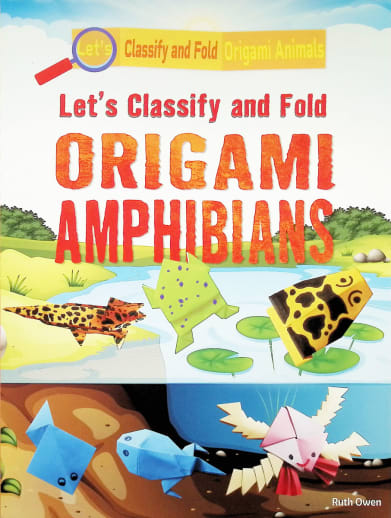From salamanders to toads, amphibians are some of the most interesting animals on Earth! Some are brightly colored to stand out; some are brown or green to blend in. Some lay eggs; some give birth to live young. This book serves as an excellent introduction to the different kinds of amphibians—and contains an origami folding activity to accompany each! Step-by-step instructions guide readers in the making of tadpoles, axolotls, and more in this creative STEAM title.
Let's Classify and Fold Origami Amphibians
SKU
036304
ISBN
9781978530027
Grade 3-6
These icons are designed to help you quickly understand and learn important information about our products.
Teaching Method
Traditional
Teacher-centered curriculum commonly used in classrooms that may include a text, teacher manual, tests, etc.
Charlotte Mason
A methodology based on the work of a 19th century educator who maintained that children learn best from literature (Living Books), not textbooks.
Classical
A methodology based on the Latin Trivium (three stages of learning), including the grammar stage (memorization and facts), logic stage (critical thinking), and rhetoric stage (developing/defending ideas).
Unit Study
A thematic or topical approach centered around one topic that integrates multiple subject areas.
Montessori (Discovery)
A methodology based on the work of a 20th century educator that emphasizes student and sensory-driven discovery learning and real-life applications.
Other
Other methodologies
Religious Content
Secular
Contains content contrary to common Christian beliefs (i.e. evolution).
Neutral
Avoids religious or theoretical topics or presents multiple viewpoints without preference.
Christian/Religious
Faith-based or including instructional religious content.
Learning Modality
Auditory
Learns through listening, talking out loud or reading out loud.
Visual
Learns through seeing, prefers written instructions and visual materials.
Kinesthetic/Tactile (Hands-On)
Learns through moving, doing and touching.
Multi-Sensory
Curriculum that employ a variety of activities/components.
Presentation
Sequential
Curriculum progresses through well-defined learning objectives. Emphasizes mastery before moving to the next topic.
Spiral
Topics and concepts are repeated from level to level, adding more depth at each pass and connecting with review.
Conceptual/Topical
Focus is on the “why,” often with a unifying concept as well as specific skills; coverage may be broader.
Teacher Involvement
Low Teacher Involvement
Student-led materials; parent acts as a facilitator.
Medium Teacher Involvement
A mix of teacher-led time and independent student work.
High Teacher Involvement
Teacher-led lessons; may utilize discussions, hands-on activities and working together.
Additional Materials Required
No other materials needed
Everything you need is included.
Other Materials Required
There are additional required resources that are a separate purchase.
Other Materials Optional
There are additional resources mentioned or recommended but are not absolutely necessary.
Consumable
Consumable
Designed to be written in; not reusable.
Non-Consumable
Not designed to be written in; reusable.
Our Price
$11.53 $11.53 $8.75
Rainbow Savings: $2.78
Description
Publisher's Description of Let's Classify and Fold Origami Amphibians
Category Description for Let's Classify and Fold
Learn more about animals as you create simple, animal-themed origami projects! Each of the books in this series highlights a different branch of animals and includes 6 projects. Each project is accompanied by educational information about the animal to create. These make great activities for classrooms, households, or individuals! Children can read about the animals before or after they create them. The step-by-step instructions show pictures for each step. Each project can be repeated again and again! Paper and additional supplies are sold separately.
Details
| Product Format: | Paperback |
|---|---|
| Grades: | 3-6 |
| Brand: | Enslow Publishers |
| ISBN: | 9781978530027 |
| Length in Inches: | 11 |
| Width in Inches: | 8.375 |
| Height in Inches: | 0.0625 |
| Weight in Pounds: | 0.3 |
Videos
Reviews

